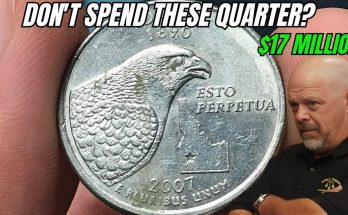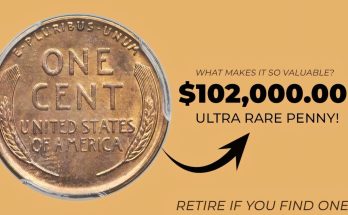💰 The Nickel Gold Mine: Most Valuable U.S. Nickels Worth a Fortune!
While the US penny errors often grab the headlines, the unassuming five-cent piece—the nickel—holds some of the most sensational and valuable stories in American numismatics. The image you see highlights the extraordinary financial potential hidden in these small coins. The truly Most Valuable and Expensive Nickels are historical rarities and minting errors that have sold for auction prices reaching well into the six and even seven figures!
The immense value of these coins is driven by a combination of low original mintage, historical significance, and spectacular errors that make them unique.
👑 The Million-Dollar Nickel: The Liberty Head Legend
There is one coin that single-handedly justifies the claim of “Nickel Millionaire”:
- The 1913 Liberty Head Nickel (The Holy Grail)
- The Story: In 1913, the U.S. Mint transitioned from the Liberty Head design (known as the “V” Nickel) to the new Buffalo Nickel. However, five pieces were mysteriously struck with the old Liberty Head design dies, despite the official change.
- The Rarity: Only five are known to exist in the world. Their sudden appearance and rarity have made them legendary.
- The Value: One of these five legendary coins, graded PR66, sold at auction for an astounding $4.56 Million. Finding one of these (though highly unlikely, as all five are accounted for) would mean instant, massive wealth.
🐃 The Buffalo Nickel Era: Famous Errors and Keys (1913–1938)
The beautiful Buffalo (or Indian Head) Nickel series is famous for its mint errors, some of which are easily spotted and carry six-figure values:
- 1937-D Three-Legged Buffalo Nickel:
- The Error: A Mint worker at the Denver facility over-polished the die to remove distracting marks, accidentally removing the Buffalo’s front-right leg, making it appear to have only three legs.
- The Value: This coin is instantly recognizable and very valuable, with high-grade examples selling for up to $99,875.
- 1918/7-D Overdate Buffalo Nickel:
- The Error: The 1918 die was stamped over a 1917 die, leaving clear traces of the number ‘7’ visible under the final ‘8’ of the date.
- The Value: A spectacular error that has sold for over $350,000 in pristine condition.
- 1916 Doubled Die Obverse (DDO):
- The Error: Features dramatic doubling of the date (1916) and the face of the Native American figure.
- The Value: One of the most significant doubled die errors in American coinage, fetching up to $281,750 at auction.
🏛️ Jefferson Nickels: Modern Treasures (1938–Present)
Even the common Jefferson Nickel has valuable rarities, often linked to extreme condition or specific errors, especially during the Wartime years:
- Wartime Silver Nickels (1942–1945): Due to the need for nickel in WWII, these coins were struck in a composition of 35% Silver. They are easily identified by a large mint mark (P, D, or S) above Monticello on the reverse. While most are worth only a few dollars for their silver content, the errors are valuable:
- 1943-P 3 Over 2 Overdate: Traces of a ‘2’ are visible under the ‘3’ in the date. Value up to $16,450.
- 1945-P Doubled Die Reverse (DDR): Noticeable doubling on the reverse inscriptions. Value up to $18,800.
- 1950-D Jefferson Nickel: Not an error, but a key date due to its low mintage of just 2.6 million coins. Uncirculated examples are highly desired by collectors and sell for hundreds of dollars.
- Full Steps (FS) Rarity: For Jefferson Nickels, coins that show all five or six steps of Monticello clearly defined on the reverse are extremely rare due to poor die strikes. These “Full Steps” coins carry huge premiums, with some 1954-S nickels achieving $35,250 due to this single detail.
The moral of the story? Always check your nickels! That five-cent piece could be your ticket to a five-figure—or even million-dollar—payday.
Would you like me to find some helpful guides or videos on how to identify the “Three-Legged Buffalo” or the “Full Steps” rarity?



